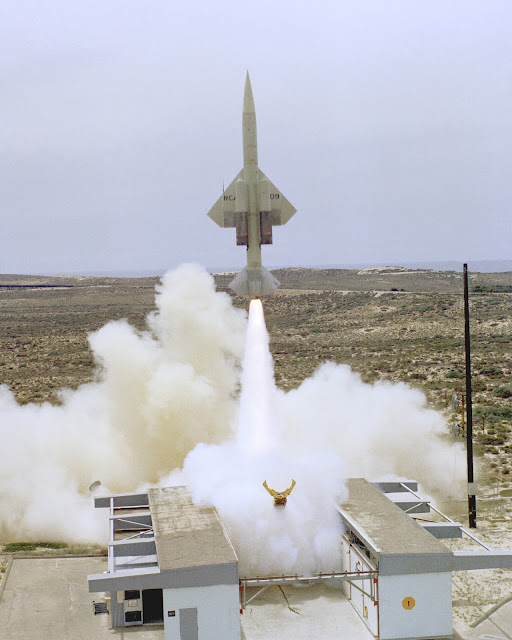On October 19, 1961, the first Boeing CIM-10B BOMARC B interceptor missile was delivered to the RCAF at RCAF Station North Bay, Ontario (operated as 446 "SAM" Squadron). A little over a year later, on December 1, 1962, the second RCAF BOMARC site became operational at RCAF Station La Macaza, Quebec (operating as 447 "SAM" Squadron). It is interesting to note that while the BOMARC was intended as a nuclear armed missile, it wasn't until August 16, 1963, that the USAF and the RCAF announced an agreement to equip Canadian BOMARCs with U.S. nuclear warheads. (This agreement also allowed the Newfie Air Force (aka the USAF F-102 units based in Newfoundland) to store nukes on their bases at Goose Bay and Stephenville.) The BOMARCs have always been controversial in Canadian aviation circles, both for the radioactive payload and what some see as their role in killing the Avro Arrow.
However, this article isn't going to focus on that, but on a rather nice image of a RCAF BOMARC being launched. (Photo courtesy of the RCAF.)
Clearly, this is an RCAF BOMARC...see the RCAF, but that doesn't look like Canada does it?
There is much debate in the historical world if photographs are primary or secondary sources. I fall on the side of primary, but my faith has been shaken over time by bad captions (clearly a secondary source), colourization, and photoshop. But if one was to use this photo as an illustration of a RCAF BOMARC launch, they would be propagating a myth.
No BOMARCs were launched in Canada, but each squadron was allowed to launch a BOMARC a year at Eglin Air Force Base. (Either at Hurlbert Field or, later, Santa Rosa Island.) Most photos show US BOMARCs being tested, but two were withdrawn from their RCAF units, sent to Florida, and "tested to destruction" (aka launched.)
So then is this Florida in the photo? Well it looks more like Florida, than North Bay, but no. The photo is playing a trick on us. After the Canadians got out of the BOMARC business in the early 70s, they returned the missiles to the USAF. So the photo is a US launch of a US BOMARC. No Canadians involved. This launch took place on November 17, 1980, at Vandenberg AFB. It is the Navy launching a former RCAF BOMARC, obviously not repainted, as a target drones to test air-to-air and surface-to-air missiles off Point Mugu.
One more Vandenberg launch, this time in 1972. (Photo courtesy of the USAF)
P.S.: Why have I always listed the missile in question as the BOMARC and not Bomarc? BOMARC is the correct term as the name of the missile was an amalgam of Boeing and Michigan Aeronautical Research Center.
P.P.S.: Did you know the BOMARC was once designated the F-99? In order to get their missiles the USAF had to fight it out with the US Army and tried to drum up the idea that their missiles were "unmanned interceptors." Ok, I guess...whatever...
Modeler's Note: Belcher Bits has a nice resin BOMARC A, BOMARC B, and launcher, available separately. The BOMARC B comes with RCAF decals. The old box scale, but I think close to 1/48, Revell BOMARC was first issued in the late 1950s but was reissued a couple of years ago. I bought one, as it is a kind of fun, if a product of its times, kit. The reissue from 2016 comes with RCAF decals as well.


1 comment:
Well done Jim.
I recall your legitimate complaint about nuclear BOMARC’s potential detonations over Canadian population centers in defense of the U.S.
It would be a bit more thorough if you had mentioned your sources on deployments and U.S. launches of an RCAF BOMARC.
Post a Comment